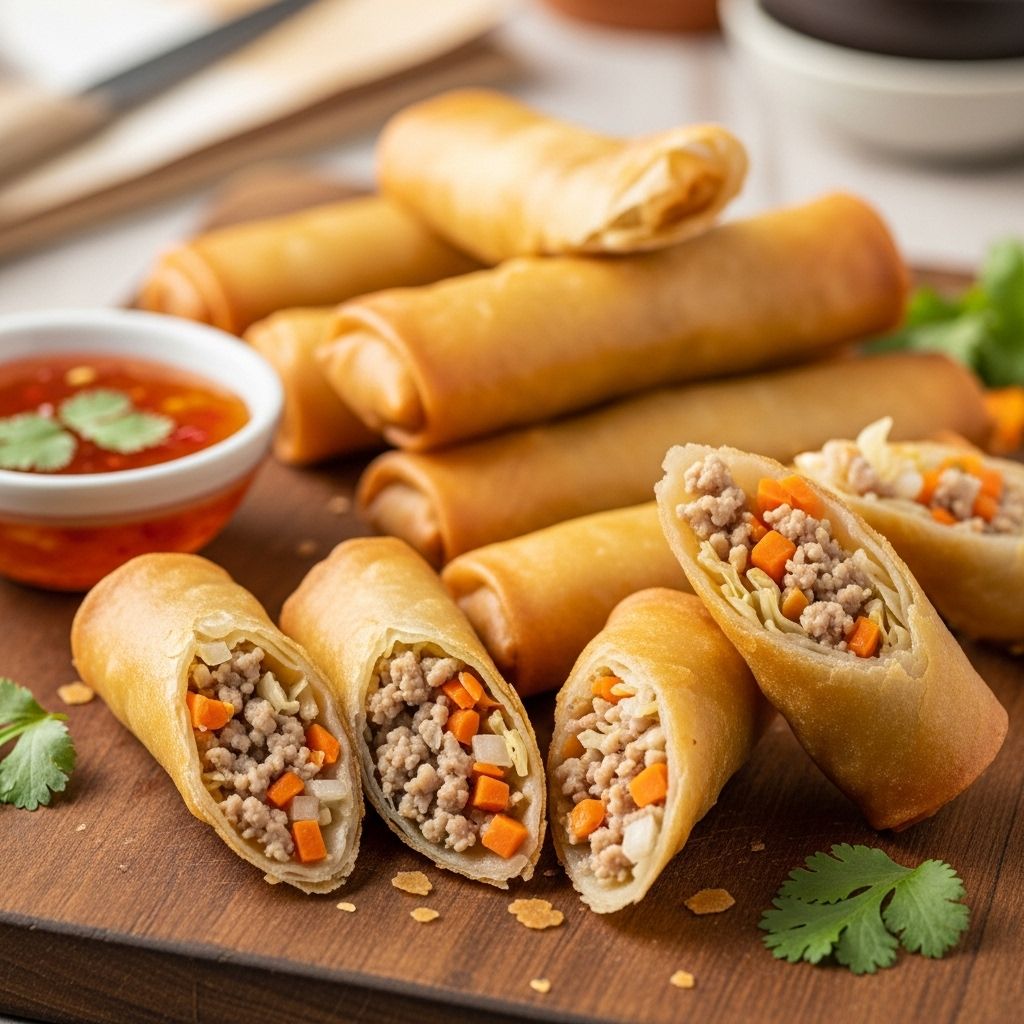Filipino Lumpia Recipe: Step-By-Step Guide To Crispy Perfection
Discover the secrets to making authentic Filipino lumpia at home—from prepping the filling to rolling, frying, and serving these golden spring rolls.

Image: HearthJunction Design Team
Traditional Filipino Lumpia: Crispy Perfection in Every Bite
Filipino lumpia, beloved for their crispiness and flavorful filling, are a staple in Filipino gatherings and celebrations. These thin, golden spring rolls are packed with a savory mixture of meat and vegetables, wrapped in delicate lumpia wrappers, and deep fried to irresistible perfection. The following guide provides detailed instructions and insights for crafting authentic lumpia at home, covering ingredients, preparation, cooking, serving suggestions, storage, and frequently asked questions.
What is Lumpia?
Lumpia are Filipino spring rolls, originally inspired by Chinese spring rolls but adapted to suit Filipino tastes. These rolls are typically filled with a seasoned mixture of ground pork, vegetables, and aromatics, encased in thin wrappers, and fried until golden and crispy. Lumpia are commonly served as appetizers, snacks, or party food, and are enjoyed with a range of dipping sauces such as sweet chili or vinegar.
Ingredients for Traditional Filipino Lumpia
- 1 tablespoon vegetable oil
- 1 pound ground pork
- 1/2 cup chopped onions
- 2 cloves garlic, crushed or minced
- 1/2 cup minced carrots
- 1/2 cup chopped green onions or scallions
- 1/2 cup thinly sliced green cabbage
- 1/3 cup finely minced water chestnuts (optional for crunch)
- 1 teaspoon salt
- 1 teaspoon ground black pepper
- 1 tablespoon soy sauce
- 1 teaspoon sesame oil
- 2 eggs, beaten
- 30 lumpia wrappers (can substitute with spring roll wrappers if needed)
- Oil, for deep frying
Ingredient notes: Some variations include additions like shrimp, mushrooms, or celery for complexity and texture. The classic recipe keeps it simple with ground pork and basic vegetables, but feel free to experiment with what you have on hand.
Step-by-Step Instructions for Making Lumpia
1. Prepare the Filling
Start by heating vegetable oil in a large skillet or wok over medium heat. Add the ground pork, breaking it up as it browns. Cook until no longer pink. Add onions and garlic, sautéing until fragrant and the onions are translucent. Stir in carrots, green onions, cabbage, and any additional vegetables you like (such as water chestnuts or celery). Cook for another 3–5 minutes, until the vegetables are just tender but still offer a bit of crunch. Season the mixture with salt, pepper, soy sauce, and sesame oil.
Remove the pan from the heat and transfer the filling to a bowl. Let it cool to room temperature before adding the beaten eggs. Mix thoroughly to bind the filling together and give it the perfect texture for rolling.
2. Assemble the Lumpia
- Place a lumpia wrapper on a clean, flat surface in a diamond shape (one corner pointed toward you).
- Spoon about 1 to 1.5 tablespoons of filling near the corner closest to you and shape it into a narrow log.
- Fold the bottom corner up and over the filling, then fold in the sides tightly toward the center.
- Roll the wrapper away from you, tucking as you go to create a snug and even roll.
- Brush a little beaten egg along the top corner of the wrapper to seal the roll.
- Repeat with remaining wrappers and filling, keeping completed lumpia covered with a damp towel to prevent drying out.
3. Fry the Lumpia
- Heat about 2 inches of oil in a deep skillet or pot to 350°F (175°C).
- Gently lower a few lumpia at a time into the oil, careful not to crowd the pan.
- Fry, turning occasionally, until golden brown and crispy—about 3–4 minutes per batch.
- Transfer cooked lumpia to a paper towel-lined plate to drain excess oil.
Serve hot and enjoy with your favorite dipping sauce!
Tips for the Best Lumpia
- Keep wrappers moist: Lumpia wrappers can dry out quickly. Work in small batches and keep unused wrappers covered with a damp cloth.
- Cool the filling: Allow the cooked filling to cool before wrapping to prevent the wrappers from getting soggy or tearing.
- Seal well: Be sure to seal each roll tightly with egg wash to prevent them from unraveling during frying.
- Fry at the right temperature: Too hot oil will burn the lumpia before the inside is heated, while oil that’s too cool will make them greasy. Use a thermometer for best results.
- Freeze extras: Lumpia can be frozen before frying. Arrange them in a single layer, freeze until solid, then transfer to a zip-top bag. Fry straight from the freezer, adding a minute or two to the cooking time.
Serving Suggestions
Lumpia are exceptionally versatile and can be enjoyed as appetizers, snacks, or main dishes. They are often served with a variety of dipping sauces, including:
- Sweet chili sauce
- Garlic vinegar
- Banana ketchup
- Spicy soy-vinegar dip
For a traditional Filipino feast, pair lumpia with pancit (noodles), adobo, or fried rice. Their crunchy texture makes them a crowd favorite at potlucks, parties, and special occasions.
Variations on Lumpia
- Lumpiang Shanghai: The most popular version, filled primarily with ground pork, carrots, onions, and sometimes shrimp or water chestnuts—for extra crunch and flavor.
- Lumpiang Sariwa: A fresh, unfried version with mostly vegetables, often served with a savory peanut-garlic sauce.
- Vegetarian Lumpia: Substitute meat with tofu, mushrooms, or extra vegetables—such as bean sprouts, jicama, potatoes, and green beans—for a lighter option.
- Lumpiang Hubad: “Naked” lumpia, served without the wrapper, as a stir-fried filling with rice.
Storage and Reheating Tips
- Storing: Store leftover fried lumpia in an airtight container in the refrigerator for up to 3 days. To maintain crispiness, do not stack them while still hot.
- Reheating: Reheat lumpia in an oven or air fryer at 350°F (175°C) for 5–7 minutes, or until heated through and crispy again. Avoid microwaving, as this will make them soggy.
- Freezing: Assemble lumpia but do not fry. Freeze on a baking sheet in a single layer until solid, then transfer to a freezer bag. They can be fried straight from frozen, just add extra cooking time as needed.
Frequently Asked Questions (FAQs)
What is the difference between lumpia wrappers and spring roll wrappers?
Lumpia wrappers are generally thinner and crispier than Chinese spring roll wrappers, providing a lighter, flakier crunch when fried. However, spring roll wrappers can be used in a pinch if lumpia wrappers are unavailable.
Can I make lumpia ahead of time?
Yes! Lumpia can be assembled and frozen (uncooked) for up to 3 months. Fry them directly from frozen, adding a minute or two to the frying time for perfect results.
Are there gluten-free options for lumpia wrappers?
Traditional lumpia wrappers contain wheat, but you can find or make gluten-free wrappers using rice flour and tapioca starch. The texture may vary slightly, but they can still yield delicious lumpia.
What dipping sauces go well with lumpia?
Popular sauces include sweet chili sauce, spiced vinegar (with garlic and chili), banana ketchup, and soy-vinegar blends. These enhance the savory flavor and add a tangy or sweet contrast.
Can I bake or air fry lumpia instead of deep frying?
While deep frying yields the crispiest results, you can lightly brush the lumpia with oil and bake at 400°F (200°C) for 15–20 minutes, turning halfway, or air fry at 375°F (190°C) for 10–12 minutes. Expect slightly less crispiness compared to traditional frying.
Nutrition Information
| Serving Size | Calories | Fat | Carbs | Protein |
|---|---|---|---|---|
| 1 roll (approx.) | 100–120 | 6g | 8g | 4g |
Please note that nutritional values will vary based on exact ingredients, portion size, and cooking method.
Pro Tips for Success
- Use a food processor to finely mince vegetables for a uniform filling texture.
- Let the filling cool completely before wrapping to avoid tearing delicate lumpia wrappers.
- Fry a test roll first to check seasoning and texture.
- Keep rolled lumpia covered with a damp cloth before frying to prevent them from drying out.
Conclusion
Filipino lumpia are a delicious, crowd-pleasing appetizer or snack that combine savory meat and vegetables with a satisfying crunch. Mastering the art of lumpia-making at home is rewarding and opens the door to endless variations and family traditions. With step-by-step guidance, helpful tips, and answers to common questions, you can enjoy authentic lumpia fresh from your own kitchen—perfect for sharing at any occasion!
References
Read full bio of Anjali Sayee












